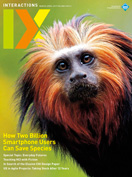Authors:
Simone Barbosa, Gilbert Cockton
This is our first issue of Interactions as the incoming editors-in-chief, very ably assisted by Rachel Clarke. We have inherited a thriving and vibrant magazine with outstanding design and content, supported by a team of excellent editors and publication managers. On behalf of our global community, we thank Ron Wakkary and Erik Stolterman for their resounding success as editors-in-chief and the robust foundations they now hand to us. They can be most proud of their achievements.
As incoming editors-in-chief, our first aim is to continue their excellent work supporting our diverse and evolving HCI communities. The Special Topic in this issue reflects this ever-broadening diversity with essays from the humanities and social sciences. These four articles and introduction from the Everyday Futures Network examine contemporary and historical aspects of technology at scale. Jenny Preece's cover feature also extends the reach of HCI and interaction design (IxD) to conservation sciences. Together, these five features demonstrate HCI's distinctive and valuable ability to look both inward (to its interdisciplinary foundations) and outward (to IxD's multidisciplinary beneficiaries).
However, diversity goes beyond academic disciplines and professional specialisms. Our second aim is to increase content across all of Interactions' media channels from currently underrepresented groups such as educators, students, design creatives, managers, and policymakers. Diversity becomes worthwhile through discussion, so our third aim is to support this through following trends in debate through letters, blogs, our website (http://interactions.acm.org/), social media, and other channels such as panels at HCI conferences.
As HCI approaches the end of its fourth decade, it is easy for newcomers to HCI and interaction design to be unaware of this now substantial history. Our fourth aim is to recollect and record major milestones in HCI history. Many Interactions readers were not born when ACM SIGCHI was established in 1983, and some were not born until after IxD became established as a new creative design discipline during the 1990s. We believe that both our younger readers and those new to HCI and IxD can benefit if we share our best memories of our collective past. As a first step here, Paul McInerney from IBM revisits his Interactions article from 12 years ago in a new feature to see what, if anything, has changed since then in the relationship between agile development practices and user experience (UX). This short piece focuses on the experiences of three UX professionals. No doubt others will have had different experiences.
Interactions is a magazine, not an archival journal. Its primary value lies in seeding debate, identifying challenges, and supporting discussion through online media and face-to-face events.
The limited space within the magazine means that definitive positions cannot be established. No content in Interactions will ever be the last word on any substantial topic in HCI or IxD. Interactions is a magazine, not an archival journal for the best HCI research and IxD practice. Its primary value lies in seeding debate, identifying challenges, and supporting discussion through online media and face-to-face events. We need to take stock of our collective pasts, question our evolving presents, and imagine our possible futures. Through this, we will address our fifth aim of identifying critical challenges for HCI and IxD communities. The first part of Bill Gaver and Kia Höök's Confessions piece addresses one such challenge: How does HCI, with its origins in science and engineering, properly embrace creative IxD research and practice? We invite your responses to this challenge and to any other content in Interactions.
We look forward to working with the HCI and IxD community to deliver on these aims.
Simone Barbosa and Gilbert Cockton
[email protected]
Copyright held by authors
The Digital Library is published by the Association for Computing Machinery. Copyright © 2017 ACM, Inc.







Post Comment
No Comments Found